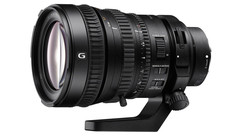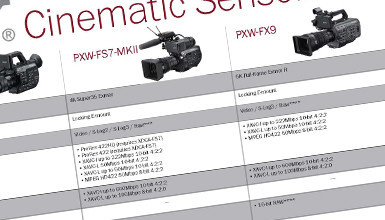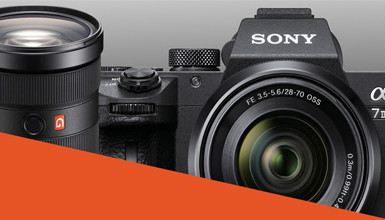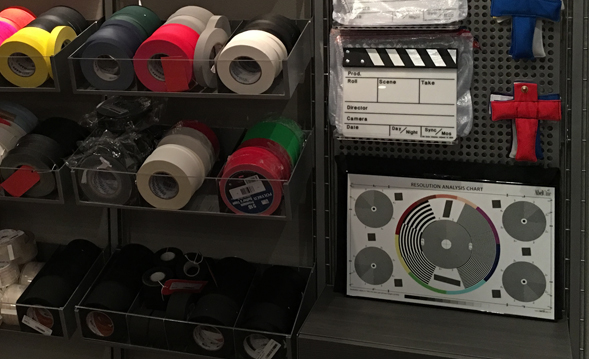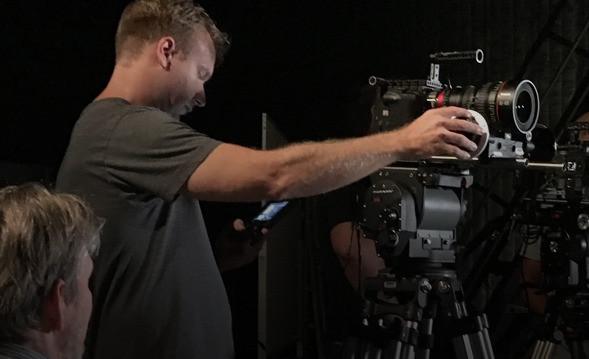Overview
The PXW-FS7M2 (FS7II) 4K E-Mount Camera builds upon the proven FS7 platform, adding the latest, state-of-the-art Sony technology, including Electronic Variable ND Filter and a robust "Lever Lock Type" Sony E-Mount. Extensive refinements to the viewfinder support system and SmartGrip arm mechanism ensure fast and secure "on the run" repositioning while still retaining the simplicity, flexibility and operational comfort of the FS7’s original design.
The new FS7 II Camcorder also supports Sony’s α Mount System with an adapter (not included), which accommodates more than 70 lenses.
Lever Lock Type E-Mount system:
Lever-Lock Type E-Mount securely holds E-Mount lenses and adapters to the camera body and enables the use of larger, heavier lenses without need for additional support. The mount can support long cine and zoom lenses of similar weight to unsupported PL-Mount lenses on the F55 (under static and dynamic loading). All the usual benefits of the E-Mount are retained.
Operating the FS7 II Lever Lock Type E-Mount is similar to operating the PL-Mount common to most cinema cameras.
Simply place the E-Mount lens in the Lever Lock Type E-Mount opening and then, with your free hand, rotate the locking ring in a counterclockwise direction. This securely clamps the E-Mount lens in the mount. When the ring comes to a stop, a secondary latch automatically locks the ring in place to prevent unintentional disengagement. To disconnect the lens, switch off the secondary latch, then rotate the locking ring in the clockwise direction to release the lens.
Electronic Variable ND:
Sony’s Electronic Variable ND technology, first introduced in the FS5, provides “run and gun” filmmakers with a whole new means to seamlessly adjust exposure while shooting. This Electronic Variable ND frees the lens iris from the traditional job of exposure control; the lens iris can be dedicated instead to the important job of setting depth-of-field. Bright exteriors and dim interiors no longer result in distracting variations in depth-of-field, which is especially beneficial in documentary field work.
The Electronic Variable ND also permits any lens to be used consistently at its “sweet spot,” or within its best f-stop or T-stop range (peak optical performance for that particular lens). In so doing, this Variable ND avoids the image degradation and softening that typically accompanies opening or closing the lens iris too much.
The FS7 II offers three different Variable ND operation modes: Preset Variable ND, Manual Variable ND and Auto Variable ND. Large, easily accessible switches on the front/right side of the camera permit quick switching between these modes while the camera is on the operator’s shoulder.
Preset Variable ND
The ND turret knob enables four presets for ND attenuation. The first preset is “clear” (or, no ND). That leaves three preset settings, which are user-selectable in 1/3 stop steps within the camera’s 2 to 7 stop range. For example, each of the three user-selectable ND presets might be set to a desired ND density for three particular scenes. In combination with iris settings, this could give each scene a particular look with regard to depth-of-field.
Manual Variable ND
This mode is ideal for “run and gun shooting,” as the operator can manually adjust exposure by turning either a knurled wheel near the front of the camera or an index-finger wheel on the SmartGrip. In either case, the result is a smooth, seamless adjustment of exposure within a 2 to 7 stop attenuation range. Both control wheels can be user-assigned to control ND density, or one of them can be reassigned to adjust audio level or lens iris (with compatible lenses).
Auto Variable ND
Auto ND can entirely replace the Auto Iris function, without any of the typical optical aberrations or degradations caused by changes of iris aperture. Auto ND will prove incredibly useful to a single-person shooting scenario, or when conducting interviews outside with the sun passing in and out of the clouds. Another critical use of Auto Variable ND is shooting time-lapse of sunset and sunrise, to ensure a steadily compensating exposure where desired.
NOTE: Any of the ten assignable buttons on the FS7 II can be assigned to toggle “Auto ND” on/off. For example, this function could be used to enable the FS7 II fast acquisition of a ballpark exposure setting, which could then be manually trimmed to user preference.
Evolution of Platform:
The third major development in the FS7 II concerns improved ergonomics and mechanical design.
A more efficient and versatile operator control layout
Buttons and controls are placed at intuitive locations for easy access while shooting. The operator (smart) side of the camera now also includes all the necessary controls for operating the new Variable ND feature. And the number of assignable buttons has increased from six to ten.
A more efficient and versatile viewfinder system
The viewfinder is the most important camera-operator interface, used for framing every shot. The viewfinder eyepiece, when in use, also provides a contact point for stabilizing the camera while shooting handheld.
The FS7 II’s stronger, simpler viewfinder support bracket makes fine-tuning or choosing a radical reconfiguration of the viewfinder’s position fast and easy. To simplify operation, the FS7’s original single lever clamp system has been replaced by a double clamp, with discrete clamping knobs for both front-to-back and vertical height adjustment. This new design facilitates adjusting the viewfinder while shouldering the camera. Another FS7 II viewfinder bracket innovation is use of square rods which retain solid LCD horizontal alignment, avoiding the gravity-driven slip and play of round support rods.
Attaching the eyepiece to the FS7 II’s LCD is simpler and easier. The FS7’s eyepiece top latch is replaced by a fixed rectangular steel loop that instantly hooks the eyepiece flush and level, perfectly aligned to the LCD. Just secure the bottom latch and you’re good to go. The FS7 II’s eyepiece uses an industry-standard 52mm diopter. By removing the rubber eyecup, the original diopter is easily switched out for a diopter matching the operator’s eyeglass prescription. The FS7 II also introduces a collapsible LCD hood for viewing the LCD without the eyepiece.
The FS7 II’s mic holder is no longer permanently attached to the end of the short 15mm rod that acts as a cross bar to join the viewfinder support bracket and the mic holder to the front of the handle. The mic holder’s lever clamp now enables removing, reorienting, or relocating the mic holder. Another benefit of the FS7 II mic holder removable clamping system is that the viewfinder and mic holder can be transposed in seconds to the opposite side. This enables the operator to comfortably shoot from the camera’s right side. This feature is often requested by experienced 16mm camera operators who once enjoyed the same flexibility from their Aatons and ARRI SRs.
Furthermore, the short 15mm viewfinder support rod can now be replaced with a longer one that allows “left eye dominant” operators to extend the viewfinder eyepiece further out for added comfort.
A smarter SmartGrip arm
The length of the FS7 II’s SmartGrip can be changed without any tools. The new design uses knobs contoured to facilitate locking and loosening by hand, even when wearing gloves. Furthermore, the new design enables relocating the SmartGrip to a new position, closer to the camera body. This makes it easier to hold the FS7 II against the chest or underarm to permit shooting more comfortably from diverse angles.
Media easier to eject
XQD cards now stand out twice as far from their slots in order to facilitate easier media changeover while wearing gloves.
HQD cards are designed to capture and transfer high-bandwidth, high res files. The QD-G256E offers an industry first 256GB capacity. This enables approximately 45 minutes at 4K/60P or 3 hours at 2K/30P. A high read speed of up to 440 MBs and write speed of 400 MBs will assist in the ability to shoot longer without changing cards. (Media sold separately.)
Signal Processing:
The FS7 II is built upon the proven FS7 platform. The specifications for the sensor, ISO sensitivity, and colorimetry all carry over. The FS7 II also has two signal processing modes: Cine-El and Custom.
Cine-El offers three color grading spaces for electronic cinematography production.
Custom mode hosts broadcast standards. Until now, Custom Mode supported ITU Rec. BT-709, HD standard. A recently adopted signal distribution and display standard, ITU Rec. BT 2020 defines various aspects of UHDTV such as display resolution, frame rate, chroma subsampling, bit depth and color space.
In keeping with the times, the FS7 II adds BT‑2020 at UHDTV 3840 x 2160 display resolution and Y, Cb, Cr color subsampling to the Custom Mode. It is possible to record and monitor on BT 2020 compliant monitors via HDMI 10-bit 422 or SDI at 10-bit 422 with a 709 monitor LUT applied.
What's in the Box
- 1 x Sony PXW-FS7M2 4K E-Mount Camcorder - Body Only (FS7II)
Specifications
Key Highlights
- 4K Super 35mm EXMOR Sensor
- Native Sony Lever Lock E-Mount
- Supports 3rd-party lenses with adapters
- Dual recording or individual trigger
- ISO 2000
- Supports S-Gamut3Cine/S-Log 3 encoding
- Environmentally sealed electronics
- Electronic Variable ND filter
- Redesigned EVF mount & SmartGrip


















